I have been using Olympian catalytic heaters (now owned by Camco) for more than 20 years. Given that I have used these heaters for hundreds and hundreds of nights, I think I am qualified to do a long term review.
HISTORY
I bought a small Olympian 3000 (now called the Wave 3) when I purchased our 1992 Starcraft. The “3” was really too small and in 2003 Joyce and I installed a Wave 6 heater permanently in the Starcraft.

Our 2006 Fleetwood Niagara came with a forced air heater, but we knew it was not going to be optimum for heating the camping on cold winter nights, so we bought a larger Wave 8 heater prior to our maiden voyage. We did not permanently install it, but elected to use it as a space heater and move it around as our needs dictated.

In 2013 our Fleetwood Niagara was vandalized and the Wave 8 was stolen. We bought and new camper, a Milan 26RLS, and a new Wave 8.
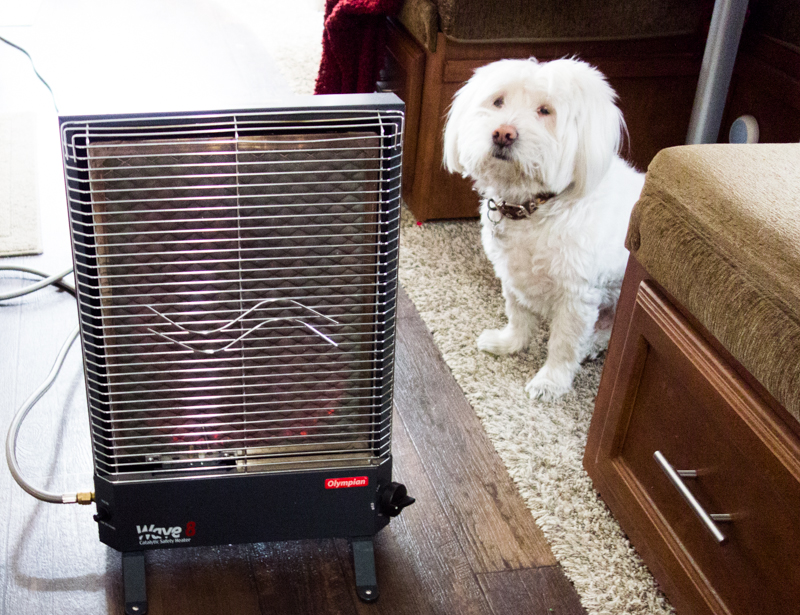
HOW AN OLYMPIAN CATALYTIC HEATER WORKS
The heater runs on low pressure propane, which is the standard system on modern campers. The heater has a pad that is imbedded with platinum. Heat is produced when the propane mixes with the platinum in the pad – this is accomplished without a flame and the surface temperature is around 720 degrees F, much less than the 2100 F temperature of a flame type heater.
To start the catalytic process, the gas control knob is pressed to allow propane to flow at the bottom of the pad, and at the same time the Piezo electric button (good for 20,000 sparks) is pressed resulting in a small flame at the bottom of the catalytic pad. As the pad heats up and gas flows behind the pad, the pad heats up. Once the pad is glowing, the knob is turned to high and the flame is extinguished. When the entire pad is glowing the knob can then be left on high or turned down to medium or low. There is no electrical connection or electric power to the heater, which is important to the camper who is not connected to the grid.
The Wave heaters are almost 100% efficient (Camco claims 99.98% and the sticker on the heater states 96% minimum), which means there is virtually no chemical emissions – however: catalytic heaters use oxygen and if the heated space is not vented, the heater will consume oxygen and death can occur due to carbon monoxide poisoning (the air becomes carbon monoxide rich due to the reduction of oxygen in the air. To mitigate this the camper needs a minimum of 24 square inches of fresh air venting, which is equivalent to opening a standard roof vent ¼” to ½” and an 8 inch wide window ¼” to ½”. Of course the prudent camper will have a functioning carbon monoxide alarm in the RV.
Over time, the catalytic pad can degrade due to “poisoning” meaning dust and other materials settling on the catalytic pad. The pads are not user serviceable and the heater will need to be returned to Camco for servicing. We use a Camco Heater Vinyl Cover on our heater when not in use and have never had a problem with pad poisoning.
Radiant Heat vs Forced Air Heating
The Wave heater produces radiant heat, which radiates heat directly to objects such as walls, furniture and people and then releasing the heat into the air. Forced air heaters (like in your house or the factory installed heater in most campers) simply heat the air. According to this article on Bob Villa’s website radiant heat is 30% more efficient than forced air systems. To understand why I think catalytic heaters are superior of campers will require some science stuff. Sorry 🙂
SCIENCE
To discuss heaters we need to understand BTU’s. The definition of BTU’s from Wikipedia is:
The British thermal unit (BTU or Btu) is a traditional unit of work equal to about 1055 joules. It is the amount of work needed to raise the temperature of one pound of water by one degree Fahrenheit (Physical analogue: one four-inch wooden kitchen match consumed completely generates approximately 1 BTU). In science, the joule, the SI unit of energy, has largely replaced the BTU.
The BTU/h is most often used as a measure of power in the power, steam generation, heating, and air conditioning industries. It is still used in some metric English-speaking countries (such as Canada, but notably not the United Kingdom). In North America, the heat value (energy content) of fuels is expressed in BTUs.
Propane BTU Facts
The amount of BTU’s in Propane is a follows:
- 1 pound of propane = 21,600 BTU’s
- 1 gallon of propane = 91,000 BTU’s
So your typical full 20lb (5 gallon) BBQ tank contains 4.6 gallons of propane (cannot be completely filled to allow for expansion) or 418,600 BTU’s.
Our camper has two 30lb propane tanks that when full have a combined 14.4 gallons of propane or 1,310,400 BTU’s. This sounds like a lot of BTU’s but read on.
Atwood Furnace Specs
Our Atwood Excalibur Furnace has an input of 25,000 BTU’s. This means it will consume 25,000 BTU’s if run continuously for one full hour. That equates to 1.16 lbs per hour. In addition, Atwood’s documentation states the furnace is 77% efficient, meaning that in an hour 23% of that propane is not used to heat the camper. Where does this 23% go – it goes out the exhaust vent. Since the furnace has a large flame, exhaust gases must be vented to the outside.
To add insult to injury, the furnace heats the entire camper. At night we only need to heat our bedroom but the thermostat is in the main part of the camper and closing those vents doesn’t work.
Aha, you say, “The furnace doesn’t run 100% of the time.” True. Our Milan has R-11 insulation in the floor, walls, and roof. At an outdoor ambient temperature of 30 F, the Atwood furnace cycles on and off, but runs 30 minutes total for each hour with the thermostat set at 68 F. So it runs 50% of the time. Our bedroom temperature runs 62 – 64 F with thermostat set at 68.
Wave 8 Specs
Because the Wave produces radiant heat we can set the heater in front of the bedroom doorway and only the bedroom is heated. Plus the heat is constant, with no swings in temperature like the furnace that cycles on and off. The only downside, if there is one, is that the Wave runs 100% of the time. However, with the wave set at low with an outdoor temperature of 30F, the bedroom stays at a constant 68F. So let’s do a comparison chart, and assume we heat the camper for 10 hours at night.
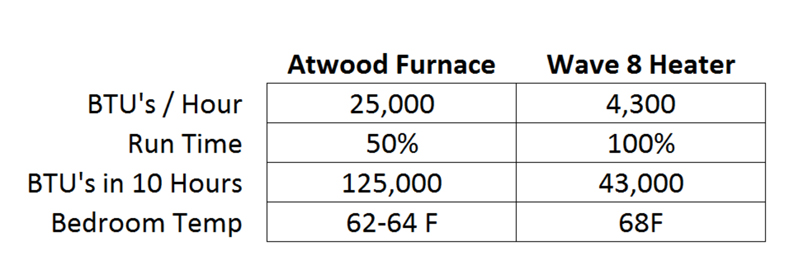
As you can see, the Wave uses about 1/3 of the propane (34.4%) and we are warmer.
But what is more important, it uses no electricity. When we are camping in December for a couple of weeks, we get the least amount of sunshine of the year. Since we rely on our solar system and battery bank to supply our electrical needs, we need to conserve as much electricity as possible. If we were to run our furnace for 10 hours per night (50% cycled on), the furnace will consume quite a few amp hours of capacity.
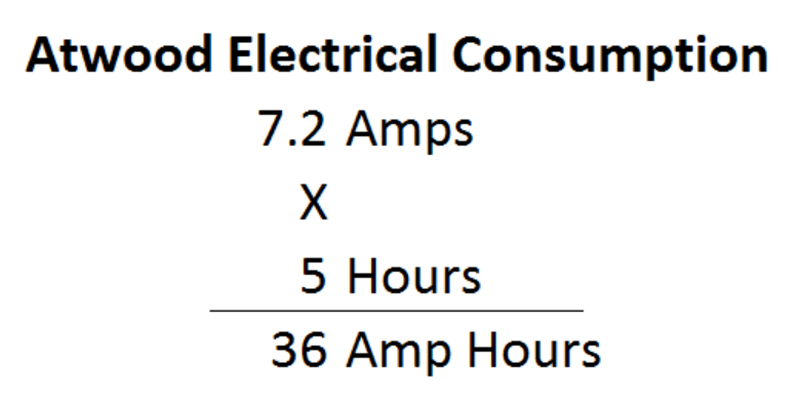
A battery bank only has about 50% of useful amp hours versus it rated capacity. It is never a good idea to deplete the battery below 50% of its capacity. However, our deep cycle 6-volt golf cart batteries can handle many more 50% plus discharges than the 12-volt Marine/RV batteries many campers use.
Let’s see what would happen if it were to rain 4 days in a row, with no sun to recharge our batteries.
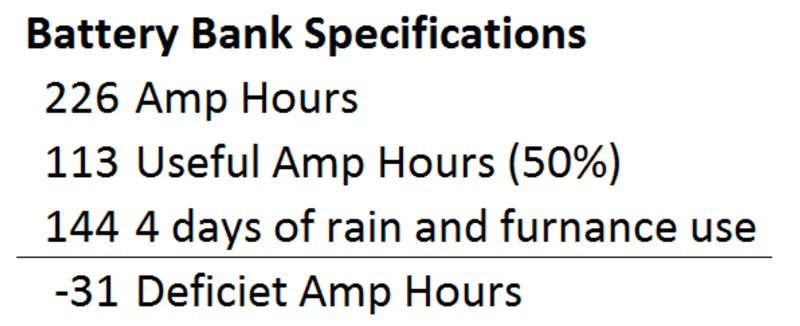
With 4 days of rain we would use 64% of our battery bank’s capacity for the furnace alone. Add in usage for the propane leak detector, lights, water pump, refrigerator thermostat, and water heater re-ignitor things would get ugly.
Of course, one could simply pay a ton more money to stay at a fully developed campground that has electricity, and crowds of people… that is no palatable to us.
SUMMARY
RV Furnaces are pretty noisy. You can hear the flame run, not to mention the blower motor churning away. Our Wave heater has a zero noise and a nice warm glow.
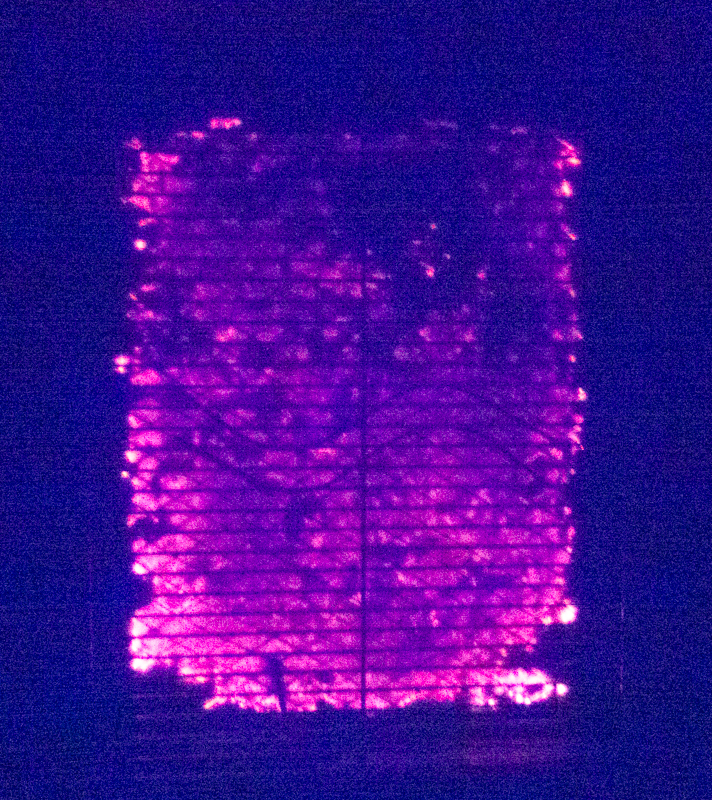
If you have a tent trailer, which has almost no insulation, the numbers are even uglier!
So how long can we camp without running out of propane? Our 2006 Fleetwood Niagara tent trailer had two 40-lb tanks and we could camp for 3 weeks with night time lows around 30F and not run out of propane.
We have also done 3 weeks in our 2014 Milan travel trailer in similar temperature ranges. At the end of 3 weeks both campers were close to empty of propane.
For more specific information you might want to read:
This website may be compensated for linking to other sites for sales of products. As an Amazon Associate I earn a small fee from qualifying purchases at no additional cost to the purchaser.

